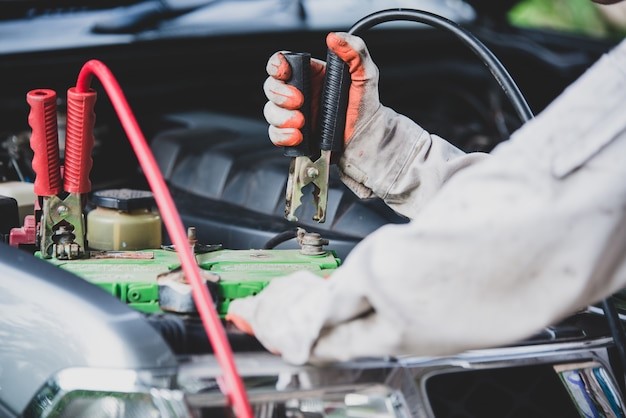Few things alarm a driver quite as much as watching the temperature gauge climb into the red zone, or seeing steam from underneath the hood. Overheating your engine is no small thing. When it’s cold out, it can do costly damage and leave you stranded if you’re unprepared.
Fortunately, knowing what to do when your car overheats will allow you to remain calm and protect your engine. In this guide, you will find what causes a car to overheat, the proper way to respond to an overheating car and how to keep your vehicle from overheating in the future.
Why Do Cars Overheat?
Engines themselves are hot running things and they naturally throw off a lot heat. The cooling system’s role is to manage this heat to maintain a safe operating temperature. If something in this cooling system isn’t working properly, heat builds up and the automobile overheats.
Learning what the most common causes of overheating are can help you get ahead of potential problems and act at the first sign of trouble.
Common Causes of Overheating
Low Coolant Levels
The coolant (sometimes referred to as antifreeze) is the liquid that circulates through your engine and radiator to help dissipate the heat away from the engine. When coolant levels get too low, heat is concentrated and runs away with the upper hand. This is largely attributed to leaks in the radiator, hoses, and water pump.
Faulty Thermostat
Your thermostat is the one that decides when coolant takes a trip around your engine. And if it becomes stuck closed, no coolant circulates, and temperatures can escalate rapidly.
Broken Water Pump
Coolant is circulated through the engine and radiator by a water pump. When the pump doesn’t work, the coolant cannot circulate and overheating can also occur within minutes.
Radiator Issues
If the radiator is clogged or leaking, it will not cool the coolant. Debris, corrosion, and damage can prevent the radiator from giving off heat.
Cooling System Leaks
Rubber hoses, gaskets and seals also degrade over time, allowing leaks in the cooling system. Even the smallest leaks can cause big problems in costly building materials if they go undetected.
Blown Head Gasket
One of the worst reasons for overheating is a blown head gasket. This can cause coolant to leak inside the engine or get mixed with the oil. It usually produces white smoke from the tailpipe and can lead to serious damage to an engine.
Warning Signs Your Engine Is Overheating
The earlier you understand and realize the dangers of overheating, the better chance you can find a way to control the damage. Watch for these indicators:
The needle on the temperature gauge in your dashboard is making its way up into the red area.
I have steam or vapor coming out from under the hood.
You can smell something sweet, indicating that coolant is leaking.
There you go you’re driving down the road and you see a light come up you’ve got an engine temp light on.
You can hear some abnormal rattling noise in the engine.
If you notice any of the signs listed above, it’s important to act right away to prevent costly upkeeps.
What to Do Immediately If Your Car Overheats
If you see your car is running hot, it is obviously going to make you anxious! But there are safety measures you can take on the spot to reduce damage and put yourself out of harm’s way. Follow this step-by-step guide:
Step 1 – Turn Off the Air Conditioner
Turn off your air conditioning now. The A/C adds more load to the engine, which can compound overheating.
Step 2 – Turn On the Heater
This may be the last thing you want to do (especially in the middle of winter), but putting the heater on high actually helps to pull heat out of the engine and into the cabin. It can lower an engine’s temperature by a smidge and maybe buy you some time to get off the road.
Step 3 – Pull Over Safely
When it is safe to do so, pull over to the side of the road (or into a parking lot). If you’re on a highway, pull over onto the shoulder, switch on your hazard lights, and stop your car.
Never ever keep driving an overheating car, even if it does not seem far to reach to your destination.
Step 4 – Shut Off the Engine
Shut off the engine after stopping. This secondary action prevents additional heat from being generated and brings any moving parts that can be damaged by high temperatures to a stand while the occurrence is forming.
Step 5 – Wait Before Opening the Hood
Raising the hood too soon can be perilous. The system is pressurized, and boiling coolant can spray out and result in severe burns. Allow the engine to cool for at least 15 to 30 minutes before you try to open the hood.
If you’re in doubt that it’s safe to move, it’s best to wait longer or seek help.
Step 6 – Check the Coolant Level
After the engine has cooled, open the hood slowly. Locate the coolant reservoir, which is generally a see-through plastic tank near the radiator with minimum and maximum level markings.
If the coolant is low and so is the tank, adding should fix it. But keep in mind that low coolant may be an indication of a more serious issue.
How to Safely Add Coolant or Water
If you are low on coolant and have the necessary materials, you can add water to lower your engine’s operating temperature. Here is how to do it safely:
Precautions Before Opening the Radiator Cap
Do not open the radiator cap when engine is hot. The coolant is pressurized, and removing the cap prematurely can cause it to spray out.
When the engine is completely cool.
Hold a thick rag or towel to protect your hand.
Open the radiator cap gradually to the first notch, and if there’s still any pressure, you’ll hear it release.
Then get rid of it altogether once you’re certain it’s safe.
Step-by-Step Coolant Refill
Find the Radiator and the Coolant Reservoir
The radiator cap is on top of the radiator, and the coolant reservoir is typically located nearby.
Check Coolant Level
If deco, check res and rad. If either is empty or low, it’s probable cause of overheating.
Add Coolant or Water
If you’re using premixed coolant, pour into the radiator and reservoir up to the full line. If you don’t have coolant handy, you can use this as a temporary solution to get you to a mechanic.
Replace the Cap Securely
Also ensure that you have both caps on tight.
Restart the Engine and Monitor Temperature
Restart the Vehicle and Watch the Temperature, Fire up the car and watch the temperature gauge. If it returns to a safe measurement, you might be able to drive cautiously to a service center.
When to Call for Roadside Assistance
In some cases, pouring in coolant or water may help, but there are situations in which you should not attempt to drive the car any longer. Call for professional help if:
- The steam comes even once you’ve already put in coolant.
- The temperature indicator won’t go below the red.
- The engine starts knocking or runs with a rough idle.
- You notice big pools of coolant on the ground underneath the car.
- If you see white smoke coming out of your exhaust, suspect a blown head gasket.
Ignoring an overheating Car Repair will lead to complete engine meltdown very soon, sometimes the same day you get the engine overheating light or the next day or simply a few hours of driving and until reaching your destination. When in doubt, tow it.
How to Prevent Future Overheating
Although some overheating problems occur unexpectedly, many can be avoided with regular upkeep. Here’s how to reduce the risk of overheating most effectively:
Regular Maintenance Tips
Check Coolant Levels Regularly
Check the coolant reservoir regularly, at least once every few weeks and before long trips. If you notice it decreasing over time, you likely have a leak.
Inspect Hoses and Belts
As rubber hoses age, they can become hard and crack. Search for bulges, splits or wetness that might indicate a leak. You should also inspect the belts that power the water pump for wear, and ensure proper tension.
Inspect Hoses and Belts
If your thermostat has become unreliable in the past, have it checked and replaced if need be.
Replace a Faulty Thermostat Promptly
Coolant degrades as it ages and can leave sediment inside the radiator. Regularly flushing the radiator, once every 30,000 to 50,000 miles, or as recommended by your vehicle’s manufacturer, helps keep the cooling system functioning properly.
Conclusion
An overheating car can be a scary thing to have to deal with, but it doesn’t have to be. Just stay cool and follow the appropriate steps. And if you’re on the side of the road or even if you are just noticing your temperature gauge climbing, pay attention to the warning signs. Turning off your engine quickly, allowing it to cool, and checking coolant levels can help you avoid more costly damage to your engine. If your car keeps overheating and you are not sure what to do, do not play with fire. It’s just a call away, professional assistance.
Contact All 4 One Transportation Service when you need fast and reliable help at any time and any place. We have seen them all, and are prepared to provide you with a wide range of vehicle recovery services, from a jump-start and a break down recovery to an emergency towing.
FAQs
No. If your car overheats, you should pull a car over immediately. An overheated engine can create a really messed up internal situation in a very short amount of time.
Well, yes, but only for a short time. If you have water let the vehicle cool for at least 10 min and fill the Overflow Tank. But coolant doesn’t offer any corrosion protection, nor does it raise the boiling point, so be sure to replace it with the real deal as soon as possible.
You will usually need at least 15 to 30 minutes. If you are not sure the engine has had time to cool, wait longer to avoid burning yourself or other bodily injury.




